“I take care of my flowers and my cats. And enjoy food. That’s living.”—Ursula Andress
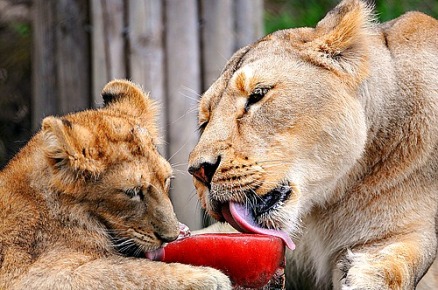
It’s Caturday! Let’s get our Cat-Care-Chat on! (OK I am a little stoked about this post.)
I had some down time today, and had a lot of fun with our cats this morning so I was inspired to share one of the tools we have been using. This particular tool helps our feline family members to feel safe, confident, and at ease with each other, and their environment, no matter where life takes them.
Today we are talkin’ bout puzzles.
Did you play with puzzles as a child? I didn’t. They were boring and frustrated me. But my younger brother did. He loved doing puzzles. Even at the age of 7 he was playing with 1,000 piece puzzles. I couldn’t believe that someone would want to sit still for that long, for days on end. I would have died of sheer boredom! But puzzles were anything but boring to my brother. In fact, he lived for them.
So what does my brother and his fascination with puzzles have to do with our animal companions?
A lot actually.
Lackluster or Enriched Lives?
Most people have limited knowledge as to how to successfully enrich the lives of their animal companions. This results in a lack of species-appropriate enrichment with most household pets. The lack of mental and physical stimulation is linked to a myriad of medical and behavioral issues in animals. But we can change that! But making a few changes to their daily routines, we can greatly enhance the lives and longevity of our animal companions!
Feline Facts
You may think your cat is fine just hanging out and lounging around all day while you are away, but I beg to differ. This is a common cat misconception. Those unwanted behaviors you are seeing are not random. Let’s look at some startling feline facts. Some of these stats might surprise you, but they are very real. These facts are at the heart of why I am so passionate about feline enrichment:
- Cats far outnumber dogs in homes (96 million cats vs. 83 million dogs). Yet cats are the number one animal euthanized at shelters due to “behavioral issues”.
- House-soiling (litter box avoidance) is the most frequently cited behavior problem for cats, followed by aggression toward people.
- Cats with medical or behavioral issues were the ones most likely to be re-homed to an animal shelter, (instead of being re-homed with friends or family members.)
- Only 1-5% of house cats have access to food toys.
- Only 0.5% of owners hide food for their cat to find.
- House cats are significantly lacking in physical AND mental exercise.
Fact: Many of these behavioral and medical issues can be prevented!
Fact: Food Enrichment can be a tool to prevent and manage many behavioral issues in homes with cats!
“Cats are captives in these environments, akin to zoo animals, and as with zoo animals, cats’ health and welfare may be affected by their surroundings. Because of this, they sometimes display undesirable behaviors when deprived of appropriate outlets for their expression.” – Environmental Enrichment for Indoor Cats, by Meghan E. Herron, DVM, DACVBa and C. A. Tony Buffington, DVM, PhD, DACVNb
Puzzles as Mental Enrichment
Now that I am older and more mature, I understand why my brother played with puzzles. It was mentally stimulating for him. It kept his mind focused and it allowed him to reduce stress. He was able to accomplish a goal and receive a reward. Using puzzles for enrichment for our cats are not that different from this practice.
Puzzles are one tool that can be used on a regular basis to encourage an animal’s natural behaviors and alleviate boredom, reduce stress, and increase confidence. Boredom often leads to frustration, and other unwanted behaviors.
The Value of Enrichment
Let’s take a look at a few very important reasons why enrichment (in general) should be a tool that we use in our homes on a daily basis. Studies have shown that when animals are given an enriched, stimulating environment (a variety of things to do, smell, and explore) they live longer, are better adjusted, more relaxed, better able to develop problem-solving skills, and they remember what they learn.
Enrichment can:
- Curb boredom and restlessness
- Reduce frustration and destructive behaviors
- Increase an animal’s natural behaviors, and as result, increase their health and longevity
- Teach you new ways to engage and play with your animal companion
Animal enrichment promotes naturalistic behaviors that stimulate the mind and increases physical activity. It reduces stress and therefore promotes overall health by increasing an animal’s perception of control over their environment and by occupying their time.
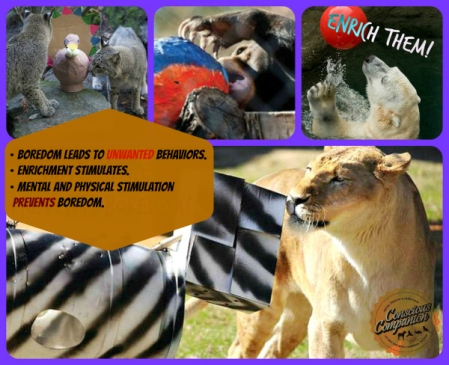
Types of Enrichment
Don’t be overwhelmed at the thought of using enrichment. You don’t have to be a wild animal expert to do this at home. And you don’t need to have a lot of time to implement this important enrichment tool. It really can be incorporated easily!
There are a variety of enrichment options, but today we will be covering food and foraging enrichment for our felines. Just so you are aware, enrichment is generally grouped into the following categories:
- Food based
- Sensory (touch, sight, smell, taste, and sound)
- Novel objects
- Social
- Positive Training
- Foraging
Foraging for Captive Big Cats
When I was the enrichment coordinator at Audubon, we utilized foraging enrichment as management tools for several species of big cats (exotic cat species). Offering our jaguars, African wildcats, snow leopards, and lions various types of puzzle feeders helped to reduce common stereotypical stress behaviors often seen in captivity. This could be anything from pacing in an exhibit or hiding. We also used puzzle feeders and hiding food to improve one’s body condition (keeping them lean), and to increase exploratory behavior (encouraging them to explore their environment to prevent boredom and increase exercise). We also used food and foraging enrichment to decrease aggression, frustration, and fear.
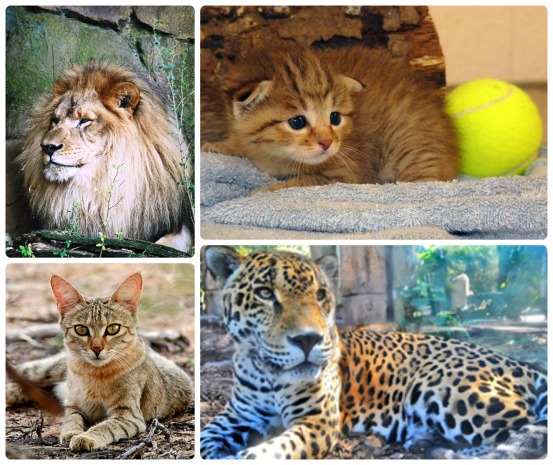
House Cats Need to Forage for Food, Too!
Our fluffy cats are not that far flung from these feline ancestors. The innate desire to explore their environment with confidence, and to hunt for their food is still very alive and well within them! Fears, frustration, aggression, and boredom are all just as common in our homes as it is for Big Cats in captivity. A stagnant environment is a breeding ground for medical and behavioral issues. As cat guardians we need to be encouraging healthy hunting and foraging behaviors. We need to be providing this kind of healthy mental and physical stimulation for our felines.
That’s where enrichment puzzles come into play!
The Semi-domesticated House Cat
House cats aren’t that far flung from their feline ancestors and modern day wildcats. But we are treating them as if they are. Companion dogs are considered fully domesticated. Cats are only “semi-domesticated“. In fact, the genomes of housecats have changed very little from their wild counterparts. And some house cats still breed with their wild relatives! Scientists now say there is very little that separates the average house cat (Felis Catus) from its wild brethren (Felis silvestris). And there is even some debate over whether our house cats fit the definition of “domesticated”. That’s why I often refer to our cats as wee “house panthers.” Our house cats need just as much enrichment that their wild counterparts receive every day.
“We don’t think cats are truly domesticated.” – Wes Warren, PhD, associate professor of genetics at The Genome Institute at Washington University

Satisfying a Feline’s Innate Need to Forage
The concept of working for food is natural for all hunters. You may see your house cat as a cuddly cat, but beneath sweet exterior is a hunter. House cats are hardwired to hunt and forage for food just like their feline kin, such as lions, tigers, and jaguars. All cats, no matter the species, are hardwired to use their highly developed senses and physical skills to hunt, capture, and kill their prey.
But are we encouraging this in our homes?
Not really.
And if it’s being done, it’s not happening enough, or done properly.
Although standard diets may adequately satisfy the nutrient needs of domestic cats, their usual presentation may not promote expression of normal hunting (exploratory) behaviors. Meeting nutrient needs in ways that mimic cats’ natural preferences provides additional enrichment. – Environmental Enrichment for Indoor Cats, by Meghan E. Herron, DVM, DACVBa and C. A. Tony Buffington, DVM, PhD, DACVNb
Make Them Work for Food!
Cats in the wild hunt for their food. Not only is it in their nature to capture and kill, but they LOVE it. Your feline family member should be “working” for their food, too. Even if they are not living in the wild, they still should have access to this wild instinct! Hunting is a natural feline behavior, and our couch potato cats need this outlet.
Why make them work for it?!?, you might ask. Great question. A study showed that when dogs solved a problem and earned a reward they wagged their tails more. These dogs were also more likely to try to solve the problem again, rather than if they were just given a reward. The study also found that food was a preferred reward, compared to spending time with another dog, or being petting by a familiar human.
I have yet to see any studies that parallel this with cats , but from my professional experience with exotic cats and personal experience with house cats, all of these species get very excited when they have to work for a treat or for their meal!
Cats who are living in the wild will forage and hunt on and off for hours. They will also eat 10 to 20 small meals throughout the day. But with our house cats, when we provide commercial cat food, we have removed the ability of housecats to hunt for survival.
But that innate desire and need to hunt is STILL present within your feline friend.
Housecats need foraging opportunities! Most of them spend as much time eating out of a food dish as they would be foraging and eating in the wild!
“This has led to an obesity epidemic in pet cats. Many of these cats eat out of boredom. But foraging allows cats the activity and the entertainment of ‘the hunt.’” – Ilona Rodan, veterinarian and co-chair of the AAFP’s Feline Behavior Guidelines.
Foraging Felines
One food-based enrichment foraging tool that you can try at home (or at your shelter) is a “puzzle feeder.” The old school (traditional) method of feeding animals out of a bowl does little to stimulate complex feeding behaviors. Food based and foraging enrichment keeps animals active and interested, while encouraging natural behaviors! These help to satisfy a cat’s natural instinct to search for their food.
I have written about this topic at length, but if you are a cat guardian who’s new to this blog, and new to the idea of food enrichment, consider trying out something simple such as the Maze Bowl. It’s an interactive slow feed bowl for cats. In the video below Knox shows us how much he loves using it. (And King Albert peeks in at the end to see if there is any leftover.)
Note: If your cat has a sensitivity to Whisker Stress, this might not be the best enrichment feeding tool.
Pick Puzzles That Are Perfect for Your Pussycat.
The Maze Bowl is what I consider the beginner puzzle level. But it’s not for every cat. It’s easy and fun for very food-motivated felines. Two of our four cats will use it; the other two would go hungry before they used it. – mainly because of their Whisker Stress. That’s why it’s important to know that there are many other styles of puzzle feeders out there!
Here are a few that our cats, or my client’s cats have had great success with, or I trust the people/companies who make them: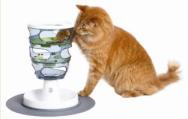
- Aikiou
- Nina Ottosson Products
- CATCH by NORTHMATE
- Foraging Toys by Fundamentally Feline
- Trixie 5-in-1 Cat Activity Center
Note: We don’t feed dry food to our felines any longer. We rotate between premade raw, canned wet food, and various freeze-dried meats. But for those of you who are feeding dry food, another option you can explore is this feeder.
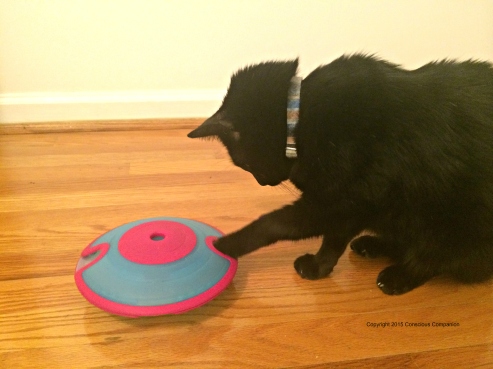
DIY Puzzles
I don’t know what I would do without recycling for enrichment. I have depended on it for nearly 20 years in both a professional and personal setting. If you love to recycle and if you/someone in your family is creative, there is no end to the puzzle feeders that you can make!
Puzzle feeders can be made of almost anything, as long as it’s safe for the cat. There are mobile devices, stationary, sturdy devices, and even devices that you can hang and they swing. Do It Yourself Puzzle feeders can be used to provide either wet or dry food
Puzzle Feeder Feeding Stations
I should mention that each of our four cats have their own puzzle feeder “feeding station.” In the wild cats are solitary hunters. Cats who are now living indoors are not exempt from this feline fact. That means at mealtime in your home, they should be solo (away from other cats). Forcing our feline family members to gobble down in a group can be very stressful to some cats.
In our home Knox is the food-frenzied feline. He used to inhale his food, then race over to the elderly cats, shove them out of the way, then gobble down their meal like a Meal Monster! Not only is this rude and stressful, but Knox is on a very portion controlled diet, so he is not allowed to have “second breakfasties.” Secondly, only one of the other cats (King Albert) will disagree with this rude behavior and set Knox straight. Mr. Beaux, the more meek and gentle senior cat, will wander off and let Mr. Eats a Lot devour his dinner.
Not cool.
And it’s really not cool for us as cat guardians to allow this behavior to occur. That’s why I love using Maze Bowls for the food frenzied feline. And that’s also why I give the senior boys their own quiet places to eat in peace.
And speaking of dining alone, any puzzle feeders that you use with your cats should be placed accordingly and safely around your home. We want these to be novel areas, and novel enrichment items, not new feeding stations that encourage competition for a highly valued primary resource (food).
Preference and Choice Matters!
It’s very important to be aware that whenever we are considering changing a high value resource (food), or how it’s offered to the animal, we must offer the new resource adjacent to the familiar resource. So if you want to try out a new puzzle feeder, such as the Maze Bowl, offer it in close proximity to where your cat’s current feeding platform or feeding bowl is currently. This allows the cat to display his/her preference for one feeding mechanism or the other. We don’t want to force our felines to use “this or that”. Cats need choices. Choice encourages confidence! When you offer your feline family member a choice, you will quickly see which one your cat prefers, and which one he/she wants to use (or ignore).
Imposing unfamiliar, undesirable resources on a cat may create an additional stressor in the cat’s environment. –Herron, DVM, DACVB and Buffington, DVM, PhD, DACVN
Encourage your Cat!
Be there with your feline family member as he discovers his new foraging toy or feeder. Encourage your cat every time she makes a small success! Don’t just leave her alone with the new toy or puzzle feeder. You wouldn’t offer a puzzle to a child, then leave him/her alone in a room to “figure it out.” You would guide the child, and encourage the child when they make progress! The same is true for our feline friends. Encourage them. Praise them when they make small progress, and reward them even when they are just trying to figure it out!
Note: Many cat guardians perceive their cats to be “finicky eaters,” recent evidence suggests that food refusal is a common feline response to environmental threat. So it’s important to look at the big picture. See what could be causing your cat to refuse to even explore a new feeding option. Remember to encourage your cat by making changes gradually.
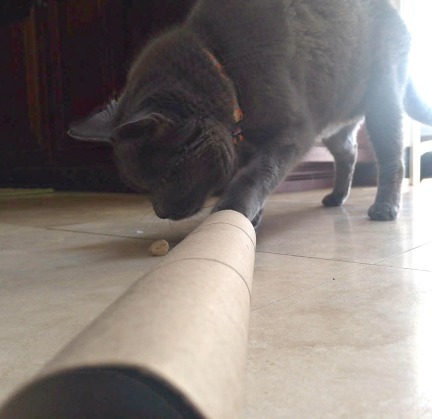
Keeping Peace with Puzzles
Food puzzles have been an excellent facilitator for making friends among felines. A couple of our cats would rather hang with us, or the dog, when given the choice. -Having another cat all up in their space is less than desirable. But puzzle feeders have bridged the gap between cats who could care less about each other.
Puzzle feeders have also been a saving grace at times when we want to keep the peace in close kitty quarters. One example of this is when we were moving. As I talked about before, all of us were confined to various hotels across the country for nearly a month. Puzzle feeders (and feeding stations) helped to keep the peace and increase kitty (and canine) confidence.
Since they Kitty Boys (and Hocus Pocus) were already acclimated to various puzzle feeders and their own feeding mats (stations) prior to the move, we were able to easily encourage each of them to focus their minds and energy onto something positive and highly rewarding while we were all crammed together. Rather than focusing on what might be a very stressful situation to them (new sights, sounds, and smells) they were so excited to forage for their food! Rather than becoming aggressive to one another, or having a full-on-feline-freak-out-fear-fest every time we had to relocate into a new hotel every day, each animal knew that once we got settled in, play time (puzzles time) was coming their way.
Puzzle feeders saved the day. And night.
Every dang day.

Positive Side to Food Puzzles
Not only do feline food puzzles encourage cats to engage in (part of) their natural predation sequence of stalking, capturing, and consuming their prey, but there are other benefits as well. If your feline is a tubby tabby like ours was, food puzzle toys can encourage cats to lose weight! And in some instances, the successful introduction of food puzzle toys has helped to resolve litter box issues. (Yes, you read that correctly; mental and physical enrichment can help with other behavioral issues in your home!).
When a cat is actively engaged in getting their food (rather than having it served to them in a boring bowl) this foraging activity encourages cats to be more active. This kind of activity increases confidence, helps to reduce stress levels, and … here’s my favorite part: cats become less demanding of their owners.
Hallelujah!
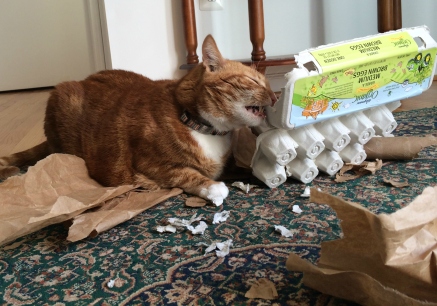
More to Come for Cats!
On October 10th I will be hosting a free member webinar on this topic. It is entitled, “Foraging Felines: Providing House Cats with Necessary Mental and Physical Stimulation Through Fun with Their Food.” I would love for you to join us!
If you missed it, you can sign up here for the replay!
For now offer your felines some food foraging fun!
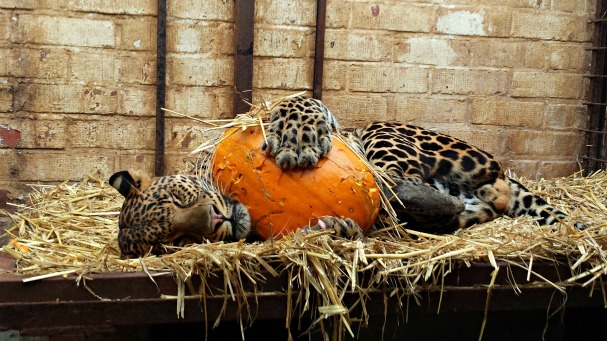
Way down deep, we’re all motivated by the same urges. Cats have the courage to live by them. – Jim Davis
Recommended Reading and Videos:
Senior Cat Enrichment – Scent Work for Senior Felines!
What’s Environmental Enrichment and Why your Cat NEEDS it.
Environmental Enrichment for Cats
Your Cat Would Like Food Puzzle Toys

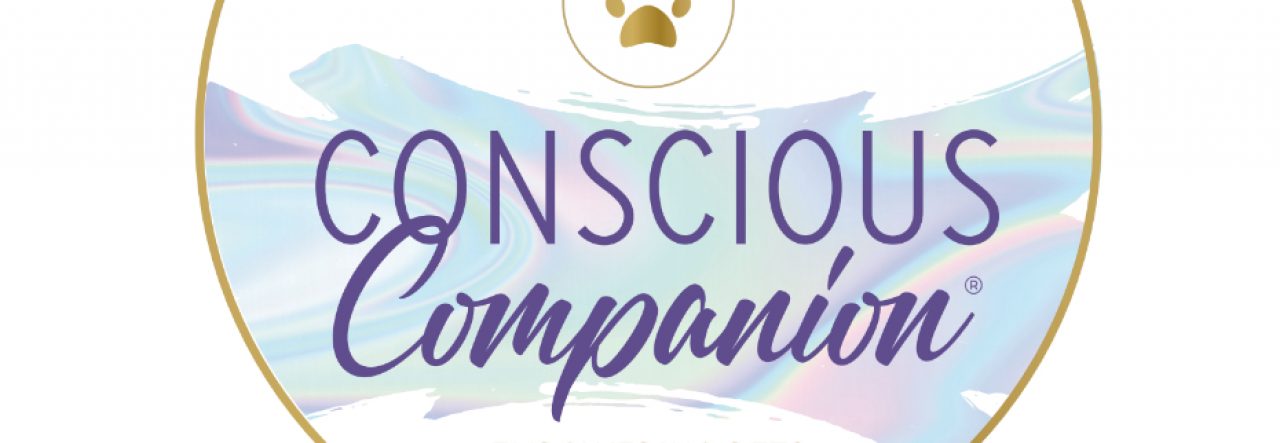
Fun!
LikeLiked by 1 person
heehee! Our Kitty Boys make enrichment feeding time so much fun! =^..^=
LikeLike
What a great article! I’m a big fan of food puzzles and recommend them to my clients frequently as easy and effective enrichment for kitties. Novelty and mental stimulation are so necessary to decrease boredom and stress, and keep cats (big and small) happy and healthy! 🙂
LikeLiked by 1 person
Woohoo! How wonderful to hear, Marci! I am so happy to know that more and more felines are receiving access to this fun enrichment option. And it’s really great to know that cat guardians are learning why and how to use these important tools for their feline family members!
Now if we can get shelters (and veterinarians) to utilize this enrichment tool, and encourage their cat adopters & clients how and when to put them into practice!
LikeLike
This is great page to read, we recently ( as in this week) got a ‘catch’ foraging feeder for our speedy eating tubby tabby, so far..he hates us :D. but he HAS pawed out a couple of peices. ( with much praise from us when he did so). we know he wont starve as hunger will make him figure it out im sure. Just not sure whether we should alternate from bowl to the feeder till he realises he now has to work for food lol. Got to try make this work as we wish to get a kitten soon and want to minimise the risk of him gobbling up the second cats food too !
LikeLike
Pingback: Skip the Stuffing. Let’s Get Reeeal. – Conscious Companion
Pingback: Thanksgiving Tips for Busy Families (plus silly bloopers) – Conscious Companion